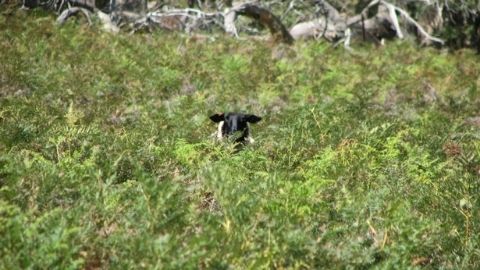Applying Behavioral Principles
We often see livestock and wildlife as eating “machines” and don't understand that an animal’s history influences its diet and habitat preferences. Animals learn from 1) social interactions with mom, peers, and people, 2) feedback from nutrients and toxins in plants, and 3) interactions with their physical environment including location of water and predators.
Behavioral principles can provide solutions to problems faced by producers and land managers. Unlike the infrastructure of a ranch such as corrals, fences, and water development, behavioral solutions often cost little to implement and are easily transferred from one situation to the next. Unfortunately, we often ignore the power of behavior to improve systems. As animals grow and develop, their interactions with the environment shape their behavior. Experiences early in life are especially critical in shaping behavior but these interactions continue throughout life. Thus, the issue isn't if animals adapt to changes in their environments - they do every day of their lives. The only question is whether or not people want to be a part of that process.
Managers often make changes in management to increase productivity. Unfortunately, these changes can cause temporary decreases in production before improving. Understanding behavior and how to “train” animals to adapt to new situations can lessen these decreases in performance. Below are stories and examples of how managers train their animals to improve efficiency and productivity. If you have a story about training animals, we’d like to hear from you. Please e-mail me at beth.burritt@usu.edu.
Application Stories
Bison Take Over Ration-Mixing in Wyoming Feedlot
The bison are in charge of ration-mixing at Iron Mountain Bison Ranch’s feedlot. Average daily weight gains have increased a quarter to a half-pound per head per day. Learn more about bison and ration-mixing.
Cows Eat Leafy Spurge
Find out how cows on the Rex Ranch in Nebraska ate leafy spurge and how they teach their calves to eat it too.
Cows Have Culture Too
Cows have culture? Learn more about understanding how livestock and landscape interacted. Find out the culture of cows.
Dairy Calves Take Grazing Lessons from Mom
Learn more about how dairy calves are taught by there mother how to graze.
Dairy Cows Train Calves to Graze
Many researchers have conducted studies exploring the behavior between cows and their calves. This article discusses how dairy cows train their calves to graze.
Exposing Animals to Grain With Mom
Improves Intake of Grain At Weaning and Feedlot Performance.
Goats Averted to Grass
Goats can be averted to grass. Learn how this is done from a seed grower and his experience averting his goats to grass.
Heifers Train Cows
Learn more about heifers, cows, and taking weanlings from Stephen Rogers as he talks about his own experience training weanlings.
Jungle Grazing
A livestock producer from Australia coined the term, 'jungle grazing'. Find out more about what jungle grazing is and take a look at some photos of 'jungle grazing'.
Kiss Your Cows Goodnight
Explore how human responses and actions affect the animals around you and what you can do about it.
Poor Quality Roughage
Animals expected to produce and reproduce on poor-quality roughage may be hindered by feeding them high-quality diet early in life. Find out why and the benefits of early exposure to poor-quality foods.
Sheep and Legumes As Partners to Control Crop Weeds
Understanding the grazing behavior of livestock can help producers control weeds in crop fields. Find out why and how this happens.













